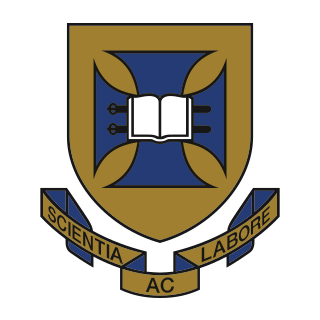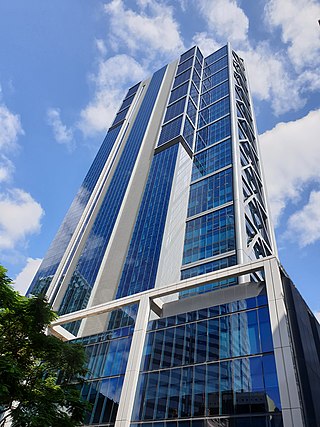Related Research Articles

The University of Queensland is a public research university located primarily in Brisbane, the capital city of the Australian state of Queensland. Founded in 1909 by the Queensland parliament, UQ is one of the six sandstone universities, an informal designation of the oldest university in each state. UQ is also a founding member of edX, Australia's leading Group of Eight and the international research-intensive Association of Pacific Rim Universities.

BHP Group Limited is an Australian multinational mining and metals public company headquartered in Melbourne, Victoria, Australia.

NICTA was Australia's Information and Communications Technology (ICT) Research Centre of Excellence and is now known as CSIRO's Data61. The term "Centre of Excellence" is common marketing terminology used by some Australian government organisations for titles of science research groups. NICTA's role was to pursue potentially economically significant ICT related research for the Australian economy.
The Business Council of Australia (BCA) is an industry association that comprises the chief executives of more than 100 of Australia's biggest corporations. It was formed in 1983 by the merger of the Business Roundtable – a spin-off of the Committee for Economic Development of Australia – and the Australian Industry Development Association. The organisation is headquartered in Melbourne with offices in Sydney and Canberra.

Camborne School of Mines, commonly abbreviated to CSM, was founded in 1888. Its research and teaching is related to the understanding and management of the Earth's natural processes, resources and the environment. It has undergraduate, postgraduate and research degree programmes within the Earth resources, civil engineering and environmental sectors. CSM is located at the Penryn Campus, near Falmouth, Cornwall, UK. The school merged with the University of Exeter in 1993.
Sir Arvi Hillar ParboAC FTSE FRSV HonFAusIMM was a business executive who was concurrently chairman of three of Australia's largest companies, Alcoa World Alumina & Chemicals, Munich Re, and Zurich Australian Insurance.

Mining in Australia has long been a significant primary sector industry and contributor to the Australian economy by providing export income, royalty payments and employment. Historically, mining booms have also encouraged population growth via immigration to Australia, particularly the gold rushes of the 1850s. Many different ores, gems and minerals have been mined in the past and a wide variety are still mined throughout the country.

Hugh Matheson MorganACMAusIMMFTSE, is an Australian businessman and former CEO of Western Mining Corporation. He was President of the Business Council of Australia from 2003 to 2005. The Howard government appointed him to the board of the Reserve Bank of Australia in 1996, where he remained until 2007. He also was the Founding Chairman of Asia Society Australia.

The Eureka Prizes are awarded annually by the Australian Museum, Sydney, to recognise individuals and organizations who have contributed to science and the understanding of science in Australia. They were founded in 1990 following a suggestion by science journalist Robyn Williams.
Peter Smedley was an Australian businessman who held senior roles with several Australian Securities Exchange listed companies.
Mount Isa Mines Limited ("MIM") operates the Mount Isa copper, lead, zinc and silver mines near Mount Isa, Queensland, Australia as part of the Glencore group of companies. For a brief period in 1980, MIM was Australia's largest company. It has pioneered several significant mining industry innovations, including the Isa Process copper refining technology, the Isasmelt smelting technology, and the IsaMill fine grinding technology, and it also commercialized the Jameson Cell column flotation technology.

John Andrew Henry Forrest, nicknamed Twiggy, is an Australian businessman. He is best known as the former CEO of Fortescue Metals Group (FMG), and has other interests in the mining industry and in cattle stations.
Donald Robert ArgusACCPASF is an Australian businessman, chairman of Bank of America Australia advisory board and member of Monash University's Monash Business School advisory board. He is a former member of Bank of America's inaugural Global Advisory Council (2013–2019); former chairman of BHP (1999–2010) and Brambles (1999–2008), former director of the Australian Foundation Investment Company (1999–2013) and former CEO of National Australia Bank (1991–1999). He was educated at the Anglican Church Grammar School.
Sir Gordon Colvin Lindesay ClarkFAusIMM was a renowned Australian mining engineer and company director. He had a profound influence on the metallurgical industry in Australia and on the attitudes of many of its later leaders. Over four decades, he was instrumental in transforming Western Mining Corporation from a small gold miner into a diversified giant.

Mark Cutifani is an Australian businessman and chair of the energy transition metals board at Vale Base Metals. He is a non-executive director of Total S.A. Cutifani is the former chief executive of mining group, Anglo American plc where he also served as a member of the Board. He was formerly CEO of South African gold mining company AngloGold Ashanti. Cutifani is a fellow of the Royal Academy of Engineering, a board member of the Hydrogen Council., recipient of the AusIMM Institute Medal. and Mines and Money Lifetime Achievement Award winner.
Frank Thomas Matthews WhiteFGS FIM FIMM FIMinE FAusIMM FGSA FCIM (1909–1971) was an Australian mining and metallurgical engineer and mineral science educator. His career included appointments in Australia, Fiji, Malaya, and Canada.
Sir George Read FisherHonFAusIMM was one of Australia's leading mining executives. In 2019, he was posthumously inducted into the Queensland Business Leaders Hall of Fame in recognition of his eminent business leadership, driving the long-term success of Mount Isa Mines and Mount Isa's growth and development as a city.
Alban Jude LynchAOHonFAusIMM was a mining engineer and academic who helped develop the mineral processing teaching experience for mining students in Australia.

James Richard MayAM FTSE HonFAusIMM was an Australian chemical engineer and company director who was the Chief Executive Officer of the Australian Minerals Industry Research Association Limited (AMIRA) between 1968 and 1994. He was also a fellow of a number of chartered institutions and organisations and was on various committees and academic institutes.
John RalstonAO FAA FTSE FRACI HonFAusIMM is a physical and colloid chemist with training in metallurgy, whose research embraces various aspects of interfacial science and engineering. He was made the Professor at the School of Chemical Technology at the University of South Australia (UniSA) in 1984. In addition, he was the Director of the Sir Ian Wark Research Institute of the UniSA between 1994 and 2012. Ralston was awarded South Australian of the Year in 2007 due to his research.
References
- ↑ "AMIRA International Company Profile". AMIRA. 2009. Retrieved 30 October 2023.
- 1 2 "AMIRA". AMIRA Global. 8 January 2021. Retrieved 30 October 2023.
- 1 2 "Australian Mineral Industries Research Association Limited (AMIRA)". Swinburne University of Technology. 2023. Retrieved 30 October 2023.
- 1 2 3 4 5 6 Burgin, Robert (2021). "THE NEXT MOVE: 50 Years of the JKMCR" (PDF). The University of Queensland . pp. 13, 14, 15. Retrieved 28 January 2024.
- 1 2 "James May". Alumni and Community. The University of Queensland. 8 January 2016.
- 1 2 Dr Richard May (26 August 2023). "Outstanding Contribution Advanced Mineral Research and Technology". The Age.
- ↑ "Prizes and Awards". AMIRA. 31 August 2023.
- ↑ "Deming Whitman". AMIRA. 2014. Retrieved 30 October 2023.
- ↑ "Amira Global Newsflash". AMIRA. 15 December 2022. Retrieved 1 February 2024.
- ↑ "Jacqui Coombes – Amira". AMIRA. 2023. Retrieved 30 October 2023.
- ↑ "Vaughan Chamberlain – Amira". AMIRA. 2023. Retrieved 30 October 2023.